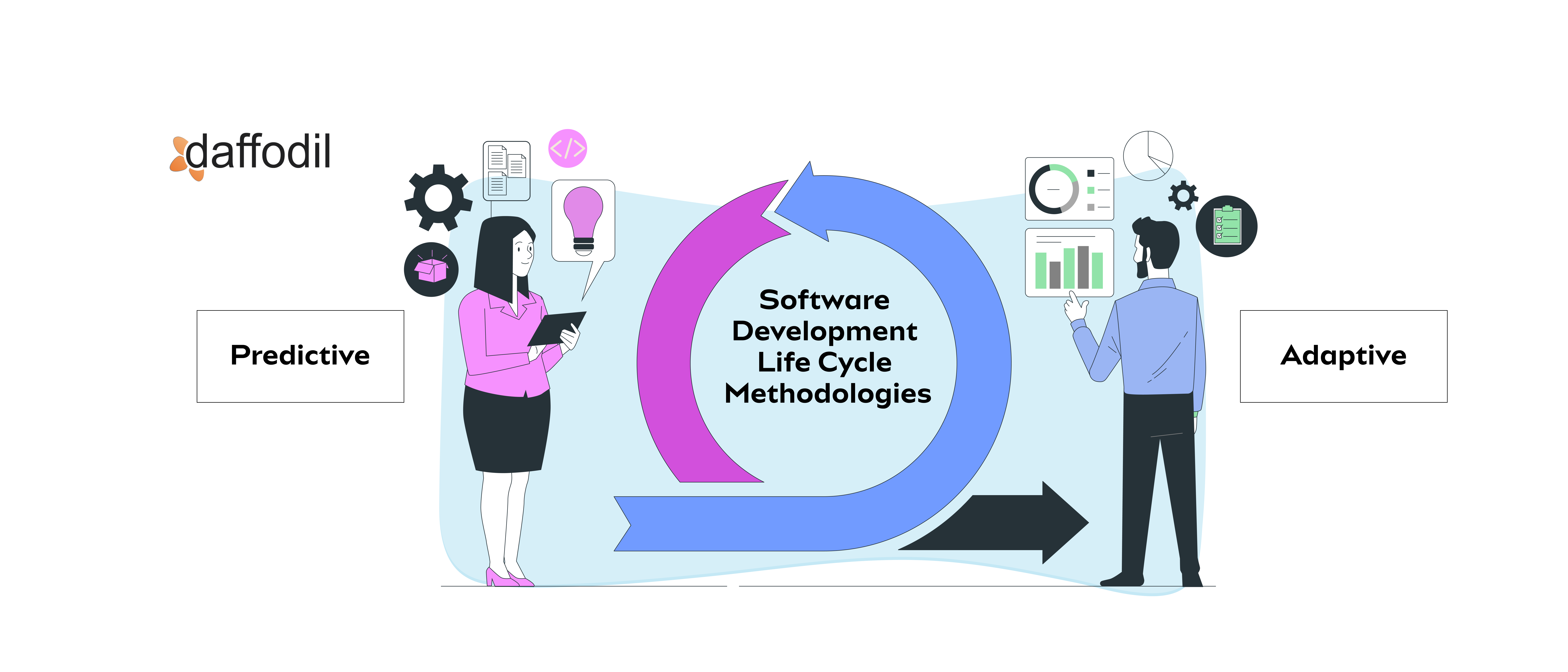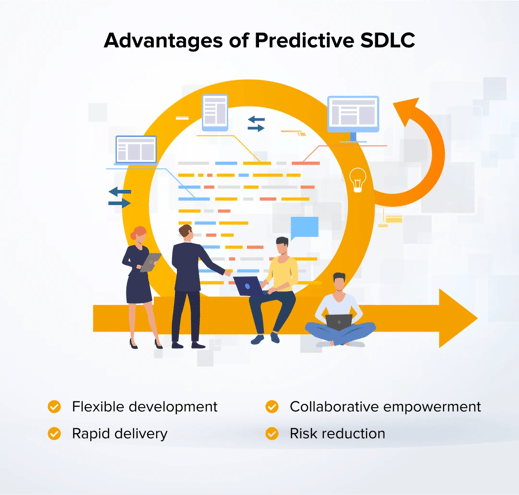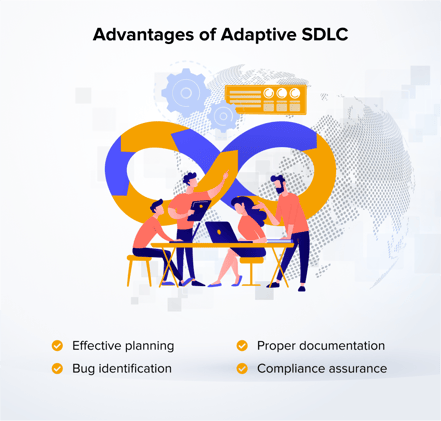
The key to a successful software development project lies in careful planning and a systematic framework. This framework acts as a roadmap, guiding developers to make well-informed decisions throughout the project. Predictive or Adaptive software development life cycle processes ensure a structured approach where all stakeholders can track the progress in multiple stages. Choosing the right software development method helps organizations manage potential risks, improve scalability, enhance project quality, control development costs, and increase team collaboration.
According to the State of Agile 2023 report, 97% of participants implement Agile methods for software development, and 88% were satisfied with the results, clearly pointing to the widespread adoption of advanced software development methodologies in recent years. Implementation of either Predictive or Adaptive software development life cycle methodology depends on the requirements and type of the project.
In the following sections, we will explore ways business leaders can strategically utilize both Predictive and Adaptive Software Development Methodologies to influence the future trajectory of their organizations. We will also discuss the advantages and disadvantages of both methodologies.
Why Business Leaders Need to Implement SDLC Methodologies
Many tech CIOs are now utilizing various software development approaches such as predictive and adaptive approaches to improve their customer experience and product quality. Business leaders can extract the following benefits from these methods:
- Structured Approach:
Predictive and Adaptive approaches help businesses set well-defined and structured goals for a project. It helps explain various stages of the development process and distribute resources accordingly.
- Quality Assurance:
Various industries require a high level of quality and reliability. A well-planned software development approach helps developers meet higher-quality requirements by implementing routine testing throughout the project life cycle.
- Risk Management:
A comprehensive risk management strategy is a fundamental part of both, Predictive and Adaptive software development life cycle methodologies. Sensitive data such as financial and security compliance require continuous monitoring and scrutiny. This practice helps identify and mitigate such risks.
- Project Management:
These software development approaches help manage and plan a development project with efficient results. These approaches help teams define a clear plan of action, and requirements throughout the projects.
- Client Collaboration:
These approaches not only put emphasis on inter-team collaboration but also focus on developer-client collaborations. It allows clients to actively participate in various stages of development and provides crucial feedback.
- Adherence to Compliance and Regulations:
Many industries such as healthcare, banking, fintech, etc. require adherence to standard regulations to prevent various threats and risks. Software development methods help businesses implement the same with projects and minimize any such risks that may hamper progress. Check out our carefully compiled portfolio of software development services, designed to serve every dimension of your technology needs here.
What are Predictive and Adaptive Software Development Life Cycle Methodologies
Since every project is different, there may be better approaches than using the same development process for each organization. Therefore, various Software Development Lifecycle Models have been developed to help increase efficiency and product quality. Broadly SDLC methodologies can be classified into Predictive and Adaptive methodologies. According to the 16th State of Agile Report, 80% of participating organizations in the survey were implementing the Agile approach as their major software development methodology. Interestingly, the survey also discovered that around 50% of organizations were implementing a combination of various methods such as Agile, Waterfall, and iterative. Let’s take a look at both approaches in detail.
1. Predictive Software Development Methodology
Predictive methodology follows a step-by-step process of managing and developing a program. This methodology comprises different models such as Waterfall, and Iterative methods. In this process, a project is tested on each stage such as designing, implementing, and testing.
The Predictive process allows developers to access different completed components of the project even before the final product is delivered, which helps avoid long development delays.
When to Use Predictive Software Development Life Cycle Approach
Since predictive methodology is a traditional development approach, it is now used in limited cases. A software development team or an IT organization may decide to go with a predictive model if the following conditions are met:
- Specific requirements: If the project requirements are pre-decided and minimal or no changes are required during the development stage.
- Long-term project: If a developer is working on a long-term project such as developing a large enterprise system. In this situation, a predictive approach can help while planning and properly allocating resources.
- Fixed budget: If the project development team is on a fixed budget and has limited resources, a predictive approach can help manage the resources from start to finish.
- Strict Regulatory Requirements: Some industries have to adhere to strict regulatory requirements such as banking, finance, and healthcare. In these cases, a software development change must go through various validations and approvals. In this case, a predictive approach ensures proper documentation of the project lifecycle.
For example, take a financial institution that is seeking to optimize its online banking platform to enhance CX, streamline transactions, etc. If they have well-defined requirements such as two-way authentication, real-time transaction processing, etc, then they should opt for this model.
Advantages of Using Predictive Methodology
Let’s have a look at some of the pros of using a Predictive methodology:

- The predictive approach gives a clear plan of action for different stages of the project.
- It makes the testing process easier by allowing developers to eliminate bugs while testing a specific step.
- It helps identify potential bugs and obstacles.
- It allows developers to maintain proper documentation and follow compliance standards.
Disadvantages of using Predictive Methodology
Just like any other method, the Predictive approach also has some disadvantages. Let’s now have a look at some of its cons:
- Comprehensive planning and execution are required at each stage of the development.
- It can be difficult to bring corrections to the program in the later stages of the project, as it can impact the entire project.
- Usually, Predictive software development is not considered suitable for complex projects.
2. Adaptive Software Development Methodology
Designed to work with complex and less certain projects, the Adaptive methodology is a change-driven approach to develop, manage, and implement the project data. Often referred to as “freeform software design”, this process gives great flexibility to all the stakeholders of the project. SCRUM or Kanban are good examples of Adaptive methodologies.
The Adaptive approach modifies the Predictive methodology by a sequential series of reflect, partnership, and grasp cycles. This process allows the developers to gain continuous knowledge and implement the same to the project in the developing stage.
When to Use Adaptive Software Development Life Cycle Approach
As a more modern and fast-paced methodology, the Adaptive software development lifecycle model is extensively used across the IT industry for developing projects. An organization may align a development project with adaptive methodology if the following conditions are met:
- Uncertain project requirements: If the final project requirements are not specific and if the developers are expected to introduce frequent changes throughout multiple phases, the adaptive approach is the right choice.
- Customer collaboration: If the customer is proactive and involved with the project development, the adaptive method helps developers meet the user requirements and modify the process accordingly.
- High uncertainty: If a project has high uncertainty about the technology, market, or product requirements, the adaptive software development life cycle approach gives developing teams the opportunity to learn, adapt, and introduce new changes as necessary.
- Small developing team: Adaptive method allows small developing teams to communicate and collaborate in a fast-paced environment, it also allows teams to make quick decisions.
- Complex and innovative projects: An adaptive approach can be helpful while working on complex and innovative projects. If a development team has to work or experiment with new technologies, an adaptive approach allows them to quickly adapt to the new framework.
For example, consider a media and online streaming platform that wishes to emphasize iterative and incremental development, and collaborations with users. The agile and adaptive software development life cycle approach can help this company provide personalized recommendations by understanding user behavior.
Advantages of Using Adaptive Methodology

- The Adaptive method allows developers to make changes to the program as the requirements change over time.
- The process results in fast and continuous delivery.
- The adaptive methodology encourages all the key stakeholders to participate and interact during the development phase.
- It reduces the risks of project failure.
Disadvantages of Using Adaptive Methodology
- Planning during the initial stages can be difficult.
- Effective implementation requires highly skilled developers.
- Frequent changes can result in improper documentation of the project.
Predictive vs Adaptive Software Development Life Cycle: Key Differences
Predictive and Adaptive software development life cycle methods have their own unique approaches to software development. While the Predictive method focuses on delivering an efficient and high-quality final product, the Adaptive approach offers stakeholders the flexibility to make changes at the development stage. Let’s look at some of the key differences between the two approaches.
|
Predictive Method |
Adaptive Method |
|
The predictive method is a Waterfall methodology |
Adaptive Method is an Agile methodology |
|
This is a traditional approach to developing software |
This is an iterative process of development |
|
Changes can not be made easily throughout the development of the project |
The process allows for easy changes during any stage of the process |
|
Testing can only be done at the implementation stage |
Testing can be done at any stage |
|
Clients are involved only during selected stages such as requirement, scope change, and implementation |
Clients are involved throughout different development stages |
|
Suitable for projects that are fully understood are less complex |
Suitable for less certain and complex projects |
|
The methodology is process-oriented |
The methodology is people-oriented |
|
The Predictive method can be implemented as an individual by a team |
The Adaptive method requires partnership or collaboration by all stakeholders |
ALSO READ: All You Need to Know About Embedded Software Development
Developing Complex Software Solutions for Agile Businesses
As technology evolves and new challenges emerge in the IT industry, adapting to different software development methodologies is essential for business leaders. These advanced approaches provide CIOs with a well-structured, high-quality software development life cycle. Whether a development team selects predictive or adaptive methodology, depends on project requirements, complexity, and the clarity of the final product.
The Predictive approach helps in well-defined projects with stable requirements, while the adaptive approach is agile, accommodating evolving project needs. Selecting the right software development approach is crucial for successful project delivery, and high-quality results in dynamic and diverse environments.
With enhanced risk management and improved customer experience, Predictive and Adaptive software development life cycle methodologies provide adaptability, compliance, and continuous improvement to product quality. It ensures the long-term success and competitiveness of organizations in the ever-evolving software landscape. Torn between Predictive vs Adaptive software development life cycle methodology would be the best choice for your business? Book a free consultation with our experts.






